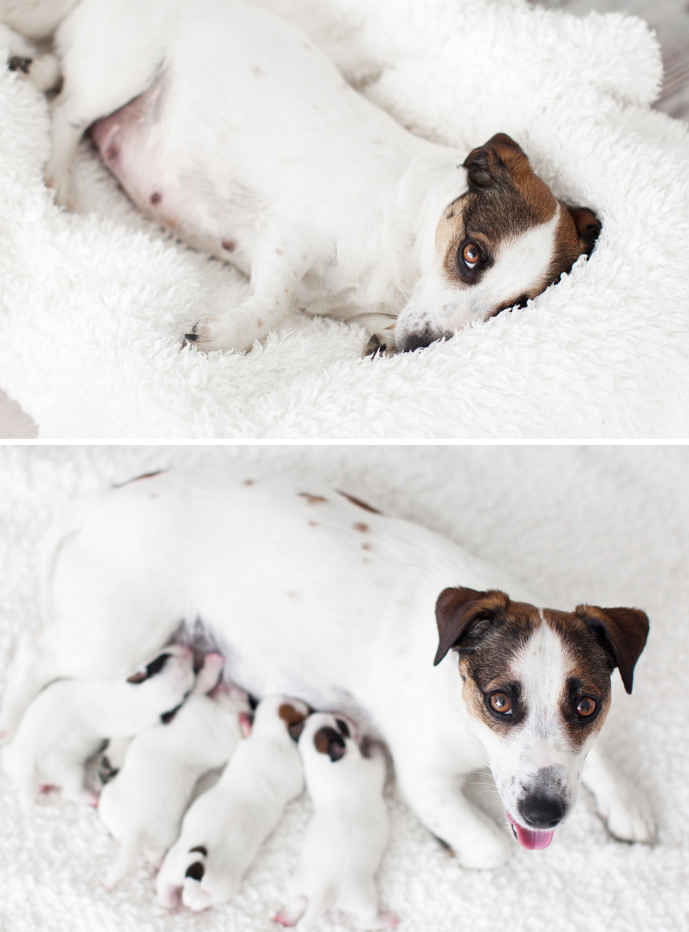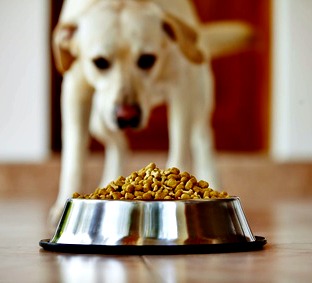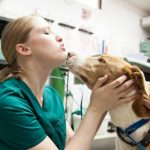
This article was updated on October 21st, 2023
“I’m worried Nala might be pregnant.” she told me. Nala’s owners had come home from the grocery store and found that the male dog they were fostering had gotten into Nala’s pen and was now tied to her. They thought that fostering an un-neutered male would be no problem because they would just put Nala away. That is, until they found the broken baby gate.
Pregnancy is one of the top concerns I have from clients when it comes to taking care of un-spayed female dogs. Unintentional breedings as well as intentional breedings are common in the dog. Of course, the question in both of those unintentional and intentional breedings is always “is my dog pregnant?”
4 Signs of Dog Pregnancy
1. Physical changes
Physical changes to the body many be seen fairly rapidly in dogs as a result of their short pregnancies with most gestations typically lasting from 58-68 days after breeding. During the first half of pregnancy, one may notice:
- larger and more prominent mammary glands. The nipples may also start to become enlarged and look more “bubblegum” pink compared to the small and more pale pink color prior to breeding. In darkly pigmented dogs, one may only notice enlargement of the nipples rather than a color change.
- The vulva of the dog may also be seen to increase in size.
- As gestation progresses to the second half of pregnancy, the mammary gland will continue to increase in size and milk production can be seen. Weight gain or increase in abdominal girth will also be noted as pregnancy progresses.

It is important to note that all of these physical changes can also be seen with pseudopregnancy (“false pregnancy”) as well. If observing these signs, further action should be taken to determine if your dog is pregnant.
2. Vaginal discharge
Vaginal discharge is common in the female throughout various stages of the reproductive cycle. Pregnant dogs may have a clear thick discharge similar to egg whites about one month post mating. If a female was to start developing a white, tan, or green tinted discharge that is fowl smelling, other reproductive health issues may be developing. Life threatening uterine infections, abnormal accumulations of uterine secretions, or miscarriages may be occurring with such discharges. Medical attention from a veterinarian should be sought at this point.
3. Appetite changes
Depending on the female, some pregnant dogs may initially become more picky about eating or may simply decrease the amount that they eat as they just adjust to hormonal changes. Some dogs that would originally eat morning and evening may just eat in the morning or may just eat in the evenings.

As pregnancy progresses, appetite often will pick up as they are now needing extra calories to maintain both themselves and the fetuses. If they are unable to get enough nutrition, you may notice a distended or larger belly while the ribs over the chest become more evident.
As there are many health conditions that cause changes in appetite, it is important to talk with a veterinarian should you notice any changes in the eating routine of your pet. This is especially true if you are seeing changes in the mammary glands, nipples, and vulva, but there was no mating of which you are aware.
4. Behavior Changes
Hormonal changes that result in pregnancy often result is behavior changes. There are a wide range of behaviors that may be exhibited in pregnant dogs. The most common observation is becoming more clingy, cuddly, or loving. In anxiety prone dogs, an increase in nervousness or separation anxiety may be noted. In rare cases, aggression towards house mates or people may develop when previously the female was very amiable.
In the late stages of pregnancy, nesting behaviors such as pacing, inability to settle down, scratching around at bedding or the ground may be observed. Adoption of inanimate objects (i.e. toys, stuffed animals, blankets, etc) and aggression when trying to take those objects away are also common findings.
How to Know For Sure If Your Dog Is Pregnant
Use a Home Pregnancy Test Kit
Most home pregnancy tests involve collecting a blood sample from the vein of the dog, and tend to be expensive ($20 to $190!). That blood is centrifuged to get either the plasma or serum off of the blood. The plasma or serum is then tested for a hormone found only in the dog placenta known as relaxin. Many of the home tests do require the owner to know how to draw blood as well as a centrifuge to spin the blood to collect the plasma or serum. It is important to note that human pregnancy tests will not work for dogs as they test for a hormone only found in humans. There is also not currently a test that uses urine of the dog to assess for pregnancy. Learn more about all the options: home pregnancy tests (our veterinarian’s reviews).
Anything Else that Can Be Done at Home?
If you have tested your dog with a home pregnancy test and get a positive result along with having the clinical symptoms mentioned above, your dog is pregnant. Of course, as the pregnancy of a dog is very short, some individuals may just elect to see what happens. If pregnant, your dog will have puppies within roughly 2 months.
Bring Your Dog to the Vet
A veterinarian can help determine if your dog is pregnant by a number of methods depending on the stage of pregnancy.
- Palpation: If your dog is a small and is a fit weight, your veterinarian may be able to palpate the fetuses starting to develop. As the fetuses grow, it can be more difficult to differentiate from other medical conditions that can cause an enlarged uterus. Palpation may also be difficult to determine pregnancy if your dog is large, overweight, or very nervous and tensing her abdominal muscles on palpation.
- Ultrasound: ultrasound can start to detect uterine vesicles (fetal sacs) developing as early as day 20-21 post ovulation. The fetal heartbeat can be detected with ultrasound between days 25-26. As it can be difficult to know sometimes when ovulation occurs if not testing for it during the breeding process, veterinarians often recommend waiting until day 28 before doing ultrasound. This ensures that if your dog was bred a few days before ovulation, the timing will still be effective to determine pregnancy.
- Hormone testing: As with the home pregnancy tests, relaxin can be tested by the veterinarian as well. It is possible to test for this hormone as early as day 21 with some of the veterinary assays.
- X-rays: X-rays are a definitive way of determining pregnancy if it is after day 48. X-rays are the most effective and recommended way to determine the number of puppies expected, which can be important for planning the birthing process as well as to be able to know if there are complications developing (i.e. not all the puppies have come out). Puppy counts are done by counting the number of mineralized heads of spinal columns noted. Prior to day 48, the skeletons are not mineralized enough to make a puppy count. X-rays cannot, however, determine if the puppies are alive and doing well.
Best Dog Home Pregnancy Tests
If you suspect that your pup may be pregnant, It’s always best seek a veterinarian’s advice. This is important to get the most accurate pregnancy test results but also to help guide you through the next steps if she is expecting. However, sometimes that may not be an option and you may be looking to check for pregnancy at home. If that’s the case, here are some of the best dog home pregnancy tests available:
Bellylabs Pregnancy Test for Dogs
This is going to be your most reliable and easy-to-use dog home pregnancy test option. It requires only a droplet of blood that can be obtained using a small lancet prick of the lip. You will then use the drop of blood according to the instructions and have results within 10 minutes. Testing can be done as early as 28 days post-ovulation (if you happen to know that date). This home pregnancy test is looking for the hormone relaxin in the blood which is only present with pregnancy. Therefore, it weeds out any false pregnancies and even abortions.

Pros: This is a simple-to-use dog home pregnancy test that offers 96% accuracy when compared to early ultrasound. Results will be received within 10-15 minutes with just a single drop of blood.
Cons:
– You’ll still need to wait 28 days before you’ll know if your dog is pregnant. Sometimes ultrasound can detect pregnancy as early as 20 days.
– Relatively high cost at ~$50-$70
Witness Relaxin Canine Pregnancy Test
Another at-home dog pregnancy test option is the Witness Relaxin Canine Pregnancy Test. As you may have guessed, this test also detects the hormone relaxin so it is able to differentiate between a false pregnancy, abortion and a true pregnancy. However, it is a little more difficult to use, requiring a blood sample that needs to be separated into serum or plasma, something that usually takes a centrifuge. Results can be read within 10 minutes and tests can be starting as early as 21 days post ovulation.
Pros: This test provides a fairly accurate early detection of pregnancy in a very short time.
Cons:
– You’ll need some higher skills to get a blood sample and get it separated into plasma or serum for the test.
– It also only comes in a five test pack, which is a little excessive if you just have one accidental breeding.
– High price close to $200
Related post: early signs of dog pregnancy: how to tell if your dog is pregnant.
You’ll find many other dog home pregnancy test options out there, but be leery. Some of these have very confusing instructions and varying degrees of reliability. However, they do tend to be less expensive. Some other dog home pregnancy tests you may see are:
HUHKOUAE Dog Pregnancy Test
- Simple use: contains all the required accessories and instructions for use, you can complete the test at home alone without taking your pet to the hospital
This test requires a small blood draw, which may be difficult to do, and has results within 15 minutes. However, there may need to be some retesting done depending on when in your dog’s cycle you run it. It even suggests buying multiple tests since you may have to repeat. This product is inexpensive and easy to get. It may be a good option if finances are tight.
EASYG Dog Pregnancy Test
Here’s another at-home test that has no instructions with it. Since most of these tests require multiple steps in order to achieve the most accurate result, not supplying directions is going to confuse some people and lead to less reliable results. Directions can be found online, but many consumers have stated there aren’t any in the package. It does require a blood draw, but is another inexpensive option.
Is a Dog Home Pregnancy Test the Best Way to Know if Your Dog is Pregnant?
There are more ways than one to find out if your dog is pregnant. It’s in your, and your dog’s, best interest to involve your veterinarian for the most accurate testing and to help you with the next steps toward a healthy pregnancy. They will be able to give you advice on nutrition for the expecting mother as well as vaccinations, dewormings, etc, that can help both mom and puppies. With this in mind, here are some ways to detect pregnancy in dogs.
1. Ultrasound
The gold standard for pregnancy detection is ultrasound by your vet. Not only will this give you a definitive yes or no of pregnancy, it can also tell you how many puppies she’s carrying. The downside is that it is most accurate after 30 days, even though pregnancy can be detected as early as 21 days, and of course, a vet visit is necessary. Obviously, ultrasound is going to be around 100% accurate, especially if around that 30 days mark. Look to pay $300-$500 for this.
2. X-Ray
If you’re willing to wait, x-rays are another option for detecting pregnancy that will give you a yes or no and a number count as well. Little puppy skeletons won’t show up until about 4-5 weeks in, so it’s a later detection method than others. If you wait long enough, x-ray is going to be around 100% accurate. Most x-rays will run you $150-$300.
3. Blood Test
These are the at-home options, but blood tests can also be performed by your veterinarian. These are the earliest detection method but can be a little difficult to do without some vet expertise and help. Blood tests aren’t going to be able to give you the number of fetuses like other methods, but they can determine between a true pregnancy or a false one. Most of these tests are over 96% accurate if done correctly at the right time. At-home tests can be as inexpensive as $10, while vet blood tests may cost $100 or more.
4. Palpation
The accuracy of this one is going to depend on the dog. Palpation is feeling for the fetusesby pushing and squishing on the outside of your dog’s belly. Around 4-5 weeks of pregnancy, most fetuses can be felt as small swellings in your dog’s abdomen. Of course, if you have a large or overweight dog, this is going to be difficult, and dogs that don’t like being touched are going to present a problem as well. Most of the time, vets will include palpation as part of a regular exam, so cost will be $50-$100.
If You Think Your Dog May Be Pregnant, Start Doing These 4 Things Now
If you know your dog was bred, but is too early to test or to see your veterinarian, it is important to to assume pregnancy to protect the puppies to be.
- Limit strenuous exercise: taking your pet on routine 10-15 minutes walks two to three times daily is perfectly healthy if your pet is used to that level of activity. Avoid doing high impact actives such playing frisbee, ball chasing, and sprinting for at least a couple of weeks during gestation.
- Provide high quality nutrition: talking to your veterinarian about a high quality adult diet is important not all for pregnancy, but also just general health. If already on a high quality diet, no diet change should be necessary for at least the first half of the pregnancy.
- Easy access rest: if ever in doubt about if your dog is pregnant, it is okay to let them chill out for a while. Making sure thy have a comfortable clean shaded rest place is important.
- Schedule a veterinary visit: taking your pet to their veterinarian to have a pre-natal examination and intestinal parasite testing will help to prepare the dam to have healthy puppies and to try to identify any potential complications that may develop with the patient. A veterinarian can also help to tailor nutrition and exercise plans to the particular patient.
FAQs
How Much Is a Pregnancy Test for a Dog?
Home pregnancy tests on the market range anywhere from $60 to $150 depending on the specific brand you choose.
What Do Dog Nipples Look Like When They’re Pregnant?
Dog nipples will often became swollen and may change in color in pregnancy. Later in pregnancy, the nipples may start screwing milk. Please note that these changes can also occur with pseudopregnancies (“false pregnancies”).
How Do Dogs Act When They’re Pregnant?
Pregnant dogs often become more clingy or depending on their owners. Some dogs will become more aggressive with pregnancy.
How Do Dogs Feel to the Touch When They’re Pregnant?
During pregnancy, dogs temperatures can run higher, so they may feel warmer to the touch. Pregnant dogs belly’s will also become larger, more distended, and hard as they get closer to parturition.
Disclaimer: This website's content is not a substitute for veterinary care. Always consult with your veterinarian for healthcare decisions. Read More.




Be the first to comment